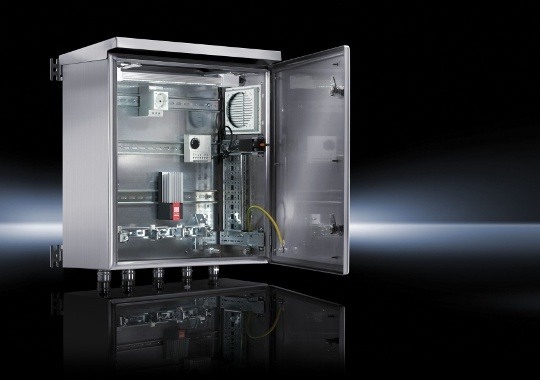By Rittal on Jan 10, 2020 2:08:00 AM

The need to place electrical equipment within corrosive environments necessitates protection beyond which painted carbon steel enclosures can provide. Enclosures made of stainless steel fill this void with superior strength and corrosion resistant properties, satisfying application requirements across a broad spectrum of industries. However, there are common criteria that must be considered to ensure that the proper stainless steel enclosure is chosen for a given application.
By definition, stainless steel is a metal alloy containing at least 10.5% chromium by mass. In a process known as passivation, the chromium within the metal forms a very thin layer of chromium oxide when exposed to the oxygen in our atmosphere. This layer continually protects the metal beneath and spontaneously regenerates if the surface is scratched � which is why stainless steel enclosures provide excellent corrosion resistance without the need for painting or any kind of surface treatment. Because of this passivation that stainless steel alloys do not display the gross surface rusting common in carbon steel alloys. If the passivation layer is destroyed beyond repair, however, corrosion will occur in the form of localized pitting.
One of the most common applications for Type 304 stainless steel is in the food and beverage industry because it gives users the ability to frequently wash the enclosure and surrounding environment without fear of rust. The ability to withstand the corrosive properties of the various acids found in meats, milk, fruits and vegetables makes Type 304 stainless steel enclosures ideal for housing controls used to operate the machinery found in food and beverage processing plants. Although Type 304 stainless steel is effective in many food and beverage settings, if the environment is overly chloride-rich or cleaning procedures involve the use of highly corrosive solvents, a switch to a stronger grade of stainless steel may be necessary.
As a general rule, Type 316 stainless steel enclosures are more reliable in harsh chemical environments than other grades. The primary exception to this rule is exposure to nitric acids, which are principally used in the production of fertilizer, pharmaceuticals, fungicides, and explosives. It can also be used for the manufacture of synthetic fibers and polymers as well as for the treatment of water. All stainless steel has some resistance to nitric acids, but in industries where nitric acids are prevalent, SAE 304 enclosures are usually preferred because of their superior resistance to this specific substance. Even though stainless steel will naturally selfpassivate, the strong oxidizing nature of nitric acid is often used to encourage this process, thereby increasing the corrosion resistance of stainless steels.

